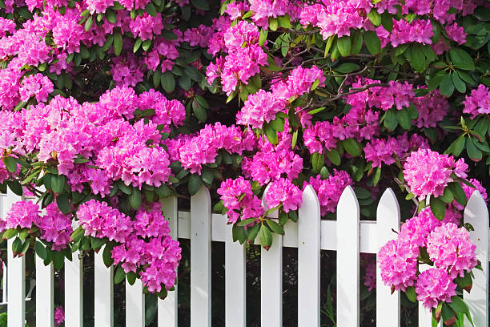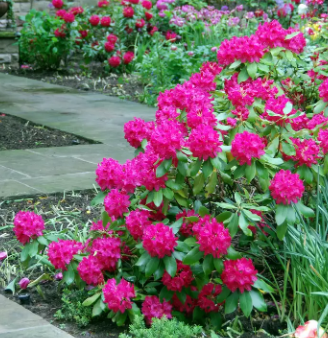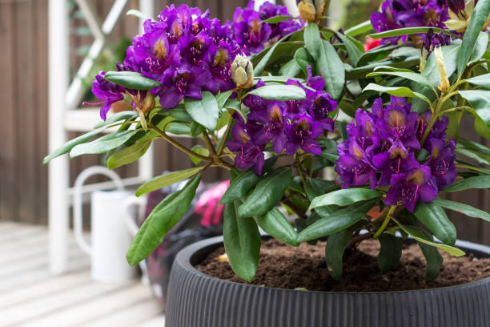Rhododendrons bring vibrant color and lush texture to any garden. These hardy evergreens are long-lived and adaptable to a wide range of climates.
Whether you’re adding them to a woodland setting, using them as foundation plants, or creating a privacy hedge, there’s a rhododendron variety to suit your landscape.
How to Incorporate Rhododendrons into Your Garden
When choosing rhododendrons for your landscape, consider their mature size, leaf color and texture, bloom time, and flower color. They fit seamlessly into both formal gardens and naturalistic designs.
While all rhododendrons are part of the Rhododendron genus, this guide focuses on evergreen rhododendrons and hybrids. These typically feature bell-shaped flowers in clusters, with five-lobed blooms and ten stamens. Their leaves are thick, leathery, glossy, oval-shaped, and deep green.

1. Use as Foundation Plants
Rhododendrons make striking foundation plants, thanks to their year-round foliage texture. You can mass-plant them for impact or mix them with other shrubs. It’s important to consider bloom color, how it pairs with your home’s exterior, and the plant’s mature height.
Low-growing varieties include:
-
R. carolinianum (Carolina Rhododendron): Reaches 3–6 feet tall in 10 years with a similar spread. Blooms in late spring with pale rose-lavender, white, or light pink flowers.
-
R. chapmanii (Chapman’s Rhododendron): Grows 3–5 feet tall at maturity. Has rounded, soft pink to rosy blooms. Heat-tolerant—ideal for south-facing beds.
-
‘Northern Starburst’ Rhododendron: Compact 4×4 ft. size with burgundy foliage and large pink blooms.
-
‘PJM Hybrids’: Grows to 4 feet tall and wide. Evergreen with reddish-bronze leaves and a variety of flower colors from pink and magenta to lavender and white.
2. Create a Living Privacy Screen
With their dense, evergreen foliage and showy spring blooms, rhododendrons are excellent choices for privacy hedges. Be sure to choose varieties that reach your desired mature height.
Great hedge varieties include:
-
‘Roseum Elegans’ (Catawba Rhododendron): 6–8 feet tall and wide with light lavender blooms.
-
R. maximum (Great Laurel): One of the largest species, grows up to 15 feet tall and 12 feet wide. Blooms in late spring with white or pale pink flowers.
-
‘English Roseum’ Rhododendron: Reaches 6–8 feet tall with deep pink flowers.

3. Mix into Garden Borders or Beds
Rhododendrons bloom in late spring and make an eye-catching addition to mixed borders or foundation beds along walkways. Their evergreen foliage and mounded form offer year-round interest.
They’re a perfect backdrop for early-blooming bulbs like daffodils, tulips, and snowdrops. In summer, pair them with hostas for texture, and with chrysanthemums in fall for added color.
Larger varieties are ideal for planting along fences or as a backdrop near ponds or hardscape features.
4. Perfect for Woodland Settings
Most rhododendrons thrive in dappled shade, making them a natural fit for woodland landscapes. Their evergreen structure adds winter interest, and their colorful blooms beautifully complement surrounding trees and bark textures.

5. Grow in Containers
If garden space is limited, rhododendrons also make great container plants. Their shallow roots suit wide pots better than deep ones. Choose a well-draining container that’s about twice the width of the nursery pot and fill with acidic potting mix.
Compact container-friendly varieties include:
-
‘Peter J. Mezzit’: A dwarf evergreen rhododendron with clusters of fragrant violet blooms in mid-spring. New foliage is light blue-green, maturing to olive green and turning copper in winter.
-
R. yakushimanum ‘Yaku Sunrise’: Deep green, slightly curved foliage with fuzzy undersides. Blossoms have magenta edges and white throats.
-
‘Ginny Gee’ Rhododendron: Blooms in mid-spring with dense pink-to-white flowers. Grows just 2 feet tall.
Things to Keep in Mind When Planting Rhododendrons
Color Palette:
Most rhododendrons bloom in white, pink, purple, or red. Some rarer cultivars come in creamy yellow or ivory. Choose shades that coordinate with other spring bloomers in your garden. Leaf color is also important for year-round interest.
Bloom Time:
Most bloom in mid to late spring, but some, like R. maximum, flower in summer. Your USDA hardiness zone will also influence bloom timing.
Mature Size:
While many rhododendrons grow slowly, always check the tag for expected height and spread. Refer to our tips above when choosing plants for foundation, privacy, beds, or containers.
Companion Plants:
As rhododendrons mature, their stems can become bare near the ground. Consider underplanting with low-growing evergreens, ornamental grasses, or shade-loving perennials to keep a lush appearance.

